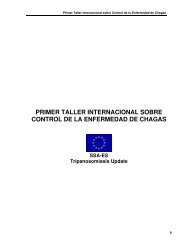El uso de Sistemas de Información Geográfica - CDIA-EC ...
El uso de Sistemas de Información Geográfica - CDIA-EC ...
El uso de Sistemas de Información Geográfica - CDIA-EC ...
Create successful ePaper yourself
Turn your PDF publications into a flip-book with our unique Google optimized e-Paper software.
<strong>El</strong> <strong>uso</strong> <strong>de</strong> <strong>Sistemas</strong> <strong>de</strong> <strong>Información</strong> Geografica y Sensores Remotos (SR) en Salud Pública<br />
Bogotá, Colombia, 27 al 30 <strong>de</strong> Marzo <strong>de</strong> 2006<br />
houses (e.g. Mott et al., 1978; Piesman et al., 1985; De Andra<strong>de</strong> et al., 1995;<br />
Gurtler et al., 1998; Sosa-Jurado et al., 2004). In the 15 <strong>de</strong>partments of Colombia<br />
where the national survey was un<strong>de</strong>rtaken, it appears that inci<strong>de</strong>nce rates in<br />
apparently infested houses are on average about 2%/year compared to 0.2% in<br />
apparently uninfested houses, confirming that (1) there is some advantage to target<br />
spraying to houses with <strong>de</strong>tectable infestations, and (2) a risk map for triatomine<br />
vectors should reflect the geographic distribution of current transmission rates.<br />
Such a risk map, if suitably validated by comparison with in<strong>de</strong>pen<strong>de</strong>nt data (eg<br />
King et al 2004), could then be used to <strong>de</strong>termine which strategy should be<br />
implemented in each locality to make best use of limited resources.<br />
Risk maps for triatomine vectors can be generated by a range of statistical<br />
techniques, but they generally involve some combination of (1) interpolation from<br />
the data collected in villages which have been surveyed and (2) statistical<br />
associations with environmental features – such as temperature, rainfall, land<br />
cover, and socioeconomic variables. To date all risk maps that have been<br />
<strong>de</strong>scribed for Chagas disease vectors have been static (Gorla 2002, Costa et al<br />
2002, Peterson et al 2002, Beard et al 2003, Dumonteil & Gorbiere 2004, Lopez-<br />
Car<strong>de</strong>nas et al 2005). Whereas a <strong>de</strong>cision-support system for Chagas disease<br />
control programmes would benefit most from a dynamic risk map, where<br />
predictions of risk are allowed to vary each year according to changing conditions,<br />
most notably in response to house spraying. Such a dynamic map could allow re-<br />
infestation rates of sprayed villages to vary geographically in response to variability<br />
in local environmental conditions (whether vegetation- or household-related).<br />
Evaluations of the effectiveness of house spraying against T. dimidiata infestations<br />
in Guatemala, for example, indicate some geographic clustering of locations where<br />
spraying has been less effective (Hashimoto K. & Codron-Rosales C., pers.<br />
comm.).<br />
In conclusion, it is worth emphasising that the introduction of Geographic<br />
Information Systems into Chagas disease control programmes should not only aid<br />
in the <strong>de</strong>velopment of evi<strong>de</strong>nce-based control strategies (i.e. policy), but will also<br />
provi<strong>de</strong> immediate help by improving the quality of data management and so<br />
improve operational capability (i.e. practice). There is consi<strong>de</strong>rable scope to make<br />
27




